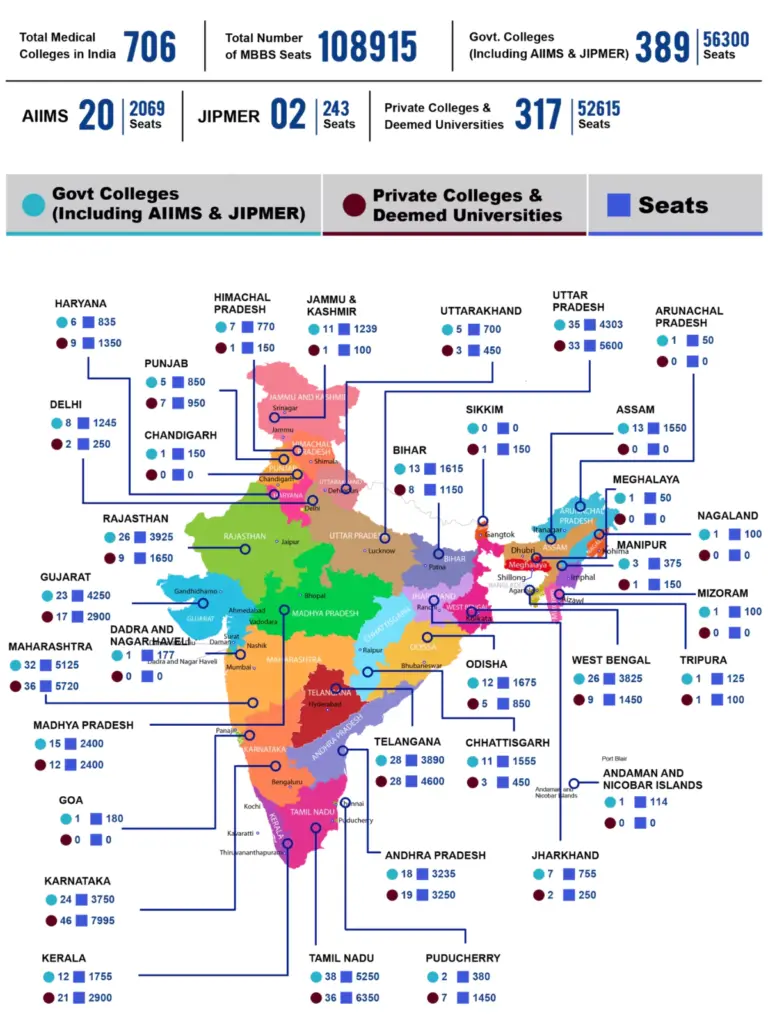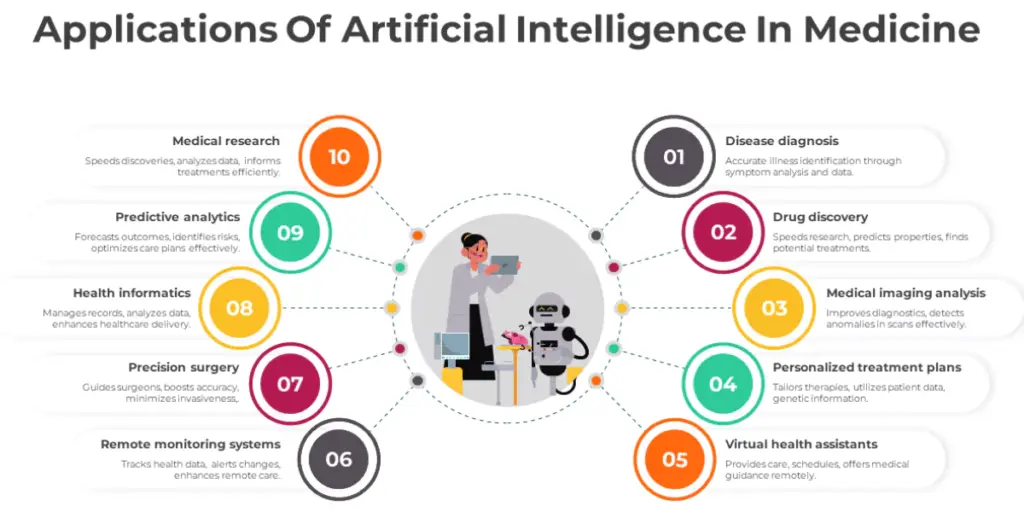Medical Education in India 2025: India’s medical education sector is undergoing a transformative phase. In September 2025, the National Medical Commission (NMC) approved a significant expansion of MBBS seats, an addition of 6,850 seats, raising the total intake to 123,700 seats for the 2025-26 academic year. This expansion aligns with the government’s ₹1,200 crore FY2025 initiative to add 10,000 MBBS seats this year and approximately 75,000 UG/PG seats in five years to meet the WHO doctor-population norm of 1:1000.
Key Developments in India’s Medical Education in 2025-26
MBBS Seat Expansion
- New Medical Colleges: 10 new private colleges (+1,200 seats) and 13 new government colleges (+1,050 seats) approved. Additional seats were also added to existing colleges.
- Access & Equity: The aim is to improve access to medical training, especially in underserved regions, and reduce the doctor shortfall (currently ~1:1263).
- Demand Pressure: Over 1.23 million students qualified for NEET UG 2025, highlighting the urgent need for more seats.
Regional Imbalances
- Southern and western states dominate college numbers:
- Tamil Nadu: 74 colleges (10% of total)
- Karnataka: 70 colleges
- Under-served states like Bihar and Assam have far fewer colleges.
- Nearly half of India’s medical colleges are in Tamil Nadu, UP, Karnataka, Maharashtra, and Telangana.
- Delhi experienced a –6.75% drop in seats due to reallocation.

Artificial Intelligence (AI) in Medical Education
- AI platforms are now used to create quizzes, assess strengths/weaknesses, and personalise learning plans.
- Case Study: RCTs show students using AI learning systems read ~50% more material and scored higher on assessments.
- Institutional Integration: KMC Manipal launched India’s first Department of AI in Healthcare (Aug 2025), offering MSc/PhD tracks and integrating AI in diagnostics and medical imaging.
Read Also: AI & Modern Technology in Indian Medical Education: Trends, Challenges & Future Roadmap
Benefits of AI in Medical Training
- Personalised learning to focus on weak areas
- Data-driven student performance tracking
- Prepares tech-savvy doctors for modern healthcare systems

Fee Hikes and Vacant Seats
- Rising Tuition: Private colleges charge ₹25–30 lakh/year; Tamil Nadu management/NRI fees range ₹27-35 lakh/year.
- Vacancies: 2,849 MBBS seats remained vacant in 2024-25.
- Financial Burden: Many students rely on loans; high fees prevent equitable access.
NEET Counselling Inefficiencies
- Delays and poor information-sharing cause withdrawals.
- Rural colleges are particularly affected by weak infrastructure and language barriers.
Calls for Fee Regulation
- NMC Fee Guidelines suggest 50% of private seats at government rates, but implementation stalled.
- Experts advocate a central fee watchdog to ensure fair access.

Regional Language Initiatives
- PM Modi supports teaching medical courses in regional languages (Tamil, Hindi) to improve comprehension.
- NMC’s Competency-Based MBBS Regulations (2024) allow bilingual instruction, improving accessibility for rural students.
- Pilot programs in MP and Tamil Nadu are already underway.
Preventing Students from Pursuing MBBS Abroad
- Limited seats and high fees drive 20,000-25,000 students abroad yearly.
- Popular destinations: Russia, Georgia, Kyrgyzstan, China, and Eastern Europe.
- Solutions: More domestic seats, NEET qualification for foreign graduates, and NEXT licensure exam.
Read Also: NEET UG 2025: 7 Reasons Why Students Choose MBBS Abroad
Read Also: Why Indian Students Are Choosing Russia & Georgia Over India?
Challenges and Regulatory Oversight
High Financial Burden
- Loans for MBBS students can result in long-term debt.
- May discourage graduates from low-paying rural or public service roles.
Read Also: Loans & Scholarships for Medical Education
Vacant Seats & Imbalances
- Thousands of seats, primarily in private or remote colleges, remain unfilled.
- Infrastructure and faculty shortages exacerbate the problem.
Faculty Shortages & Eligibility Reforms
NMC relaxed eligibility norms in mid-2025:
- Doctors with 4-10 years of hospital experience can be assistant/associate professors.
- Diploma holders and senior residents are eligible.
- Publication requirements reduced (2 papers for associate professor).
Standardised Assessment – NEXT Exam
- The National Exit Test (NEXT) will unify licensure for Indian and foreign medical graduates.
- Full rollout deferred to 2026.
- Part of the broader CBME 2024 curriculum reforms.
Also Read: NMC NExT Exam 2025: Why It is Being Delayed?
Emerging Initiatives
KMC Manipal AI Department
Kasturba Medical College has launched a Department of AI in Healthcare. This is the first in India. Its mission is to “advance research and education” by merging medicine, engineering and data science.
- Focus on merging medicine, engineering, and data science.
- AI-based degrees and cross-disciplinary research, e.g., predictive analytics and medical imaging.
Tata Group-IISc Medical School, Bengaluru
In January 2025, the Tata Group and the Indian Institute of Science (IISc) announced the Tata IISc Medical School in Bengaluru.
- ₹500 crore endowment for MD-PhD and dual-degree programs.
- Integration of research labs and clinical training to produce physician-scientists.
- Focus on oncology, neurology, and infectious diseases.
Read Also: India’s Medical Education Revolution: NMC Reforms, CBME, NEXT & More
Medical Education in India 2025-26: Growth with Challenges
Positive Trends:
- 123,700 MBBS seats
- AI-driven teaching adoption
- Strategic institutional partnerships (Tata-IISc, KMC)
Ongoing Challenges:
- High fees and vacant seats
- Regional imbalances
- Student migration abroad
Read Also: NMC Chief Proposes Medical College Rating System to Enhance Education Standards
India’s medical education system in 2025-26 is at a defining crossroads. The surge to 123,700 MBBS seats, the emergence of AI-driven teaching, and new institutional partnerships such as Tata-IISc signal unprecedented growth.
Yet the challenges of high fees, regional imbalances, vacant seats, and student migration abroad show that expansion alone isn’t enough. True transformation will depend on consistent regulation, equitable access, and technology-led learning that prepares a new generation of doctors for a rapidly evolving healthcare landscape.
With careful policy execution and smart innovation, India can shift from being a doctor-deficient nation to a global hub for medical education by the end of the decade.

